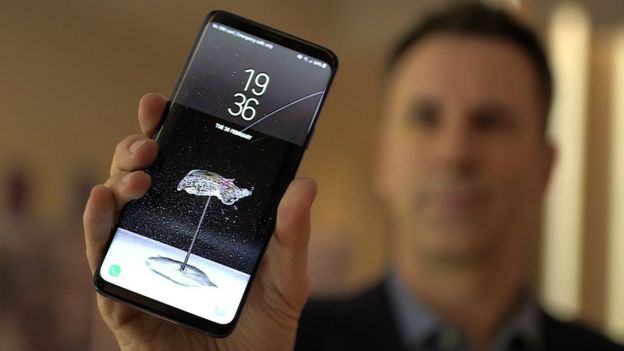

NEW and improved camera capabilities are the main thrust of Samsung’s pitch for its latest flagship smartphones, the Galaxy S9 and larger S9+.
The handsets gain a super-slow-motion facility designed to make it easy to extend key moments of action. They also gain a type of lens that should improve low-light photography.
Samsung’s sales rose in 2017 but not as fast as those of many Chinese rivals.
Experts suggest the new facilities represent minor upgrades.
That may make marketing the S9 a challenge since the phone’s design also strongly resembles that of the existing S8. Slightly smaller bezels at the top and bottom and a new position for the fingerprint sensor are the biggest alterations.
The S9+ is only a little more distinct from the S8+. It now features two camera lenses on its rear, providing different fields of view and allowing photo backgrounds to be digitally blurred.
 The S9 can automatically design an avatar or emoji for users
The S9 can automatically design an avatar or emoji for users“I’m not sure if the improvements will be enough to make people rush and upgrade,” commented Francisco Jeronimo, an analyst at market research firm IDC.
“The quality of the camera is a purchasing driver for many consumers, and Samsung’s does appear better than [Google’s] Pixel 2.
“But I was expecting to see more development around its intelligence – it still relies on the cloud, meaning you need to be connected to the net to do live translations, for instance.”
By contrast, he added, Huawei’s latest phones can translate words they are shown while offline thanks to their use of a new chip technology.
| Manufacturer | 2017 handset shipments | Year-on-year change | Market share |
|---|---|---|---|
| Samsung | 317.7 million | +2.0% | 21.7% |
| Apple | 215.8 million | +0.2% | 14.8% |
| Huawei (incl Honor) | 154.2 million | +10.7% | 10.6% |
| Oppo | 111.7 million | +12.0% | 7.6% |
| Xiaomi | 92.7 million | +75.0% | 6.3% |
| Vivo | 87.6 million | +13.4% | 6.0% |
| LG | 55.8 million | +1.2% | 3.8% |
| Industry total | 1.46 billion | -0.5% | 100% |
Source: IDC
Samsung held its launch on the eve of the Mobile World Congress tech show in Barcelona.
It has priced the S9 at 849 euros (£750; $1,047) and the S9+ at 949 euros (£838; $1,170) – 50 euros more than their predecessors
The biggest hardware change to the S9’s camera is that it now features a variable aperture, with a choice of two settings.
At its widest setting it allows in more light, which can be helpful in dim conditions, but at a cost of having shallower focus.
It is not the first handset-maker to do this. Nokia offered a similar technology in its N86 phone in 2009, but the innovation failed to catch on.
To further improve low-light imagery the S9 now takes 12 images in quick succession to help detect and remove noise – the S8 took three.
But its standout feature is the capacity to slow down video while keeping it in high-definition resolutions: 960 frames per second in 720p and 480fps in 1080p.

Sony’s Xperia XZ Premium phone added a similar feature last year, but Samsung says its version is “more usable”.
In both cases, owners must determine, at point of capture, the 0.2 seconds that get turned into six seconds of footage, at the slowest setting. This can be a challenge to get right.
While Sony relies on users pressing a button at exactly the right moment, Samsung’s S9 auto-triggers the function when motion is detected in a chosen part of the screen.
Other camera-related innovations include the introduction of AR Emojis.
 Samsung’s latest phone has a camera that adapts to different light levels
Samsung’s latest phone has a camera that adapts to different light levelsThese are animated cartoons created from facial scans of the owners that then mimic their expressions. They are similar in concept to Apple’s animal-based Animojis, but Samsung suggests its version is more “personal”.
The Bixby Vision image-recognition app gains the ability to identify foods the camera is pointed at and estimate their calorie content.
And the phone now combines data from its iris and facial-recognition systems to improve their reliability.
Samsung, however, declined to provide a failure rate to permit a comparison with Apple’s one-in-a-million statistic for its Face ID facility.
IHS Technology’s Ian Fogg said the risk for Samsung was that if consumers do not view the new features as a huge leap forward, they might prefer to wait to see what the S10 offers.
“The typical Samsung upgrader probably has an S6 or S7,” he explained
“Samsung has delivered significant incentives to upgrade with the improved camera and the larger display, compared with the older phones.
“But the problem is that those handsets from two to three years ago are still very usable and will still feel pretty good to many.”


How keen are you to see the world in ultra slooooooow motion or to have an animated emoji that looks just like you?
Samsung is betting that these are not niche interests and will spark a rush to upgrade, particularly amongst those people whose phones are a couple of years old.
In truth, the Galaxy S9 feels like an incremental improvement on last year’s S8 – the screen stretches a bit further in the same space, the sound system is louder, which means more anti-social noise in public places, and Samsung’s underwhelming Bixby assistant has got a bit smarter at reading foreign menus.
To be fair, smartphones like the Galaxy are already brilliant computers delivering extraordinary performance on the move – and making new models stand out from the crowd is a struggle for all manufacturers.
It is a good bet that the S9 will sell very well indeed and put another rocket under Samsung’s profits – it just isn’t going to make jaded phone-buyers go “wow!” – bbc.com